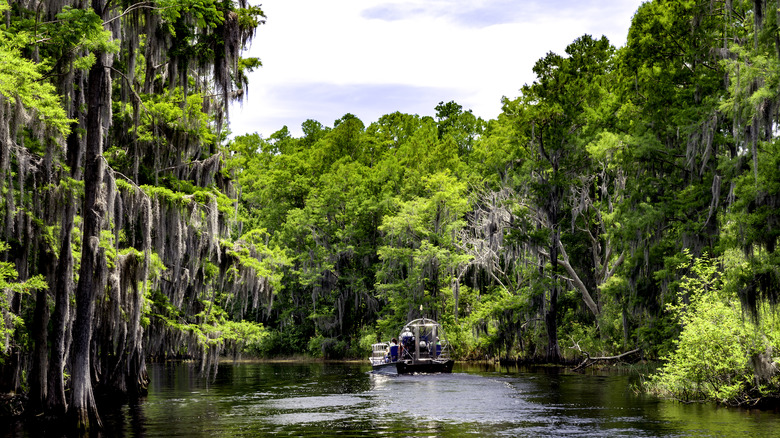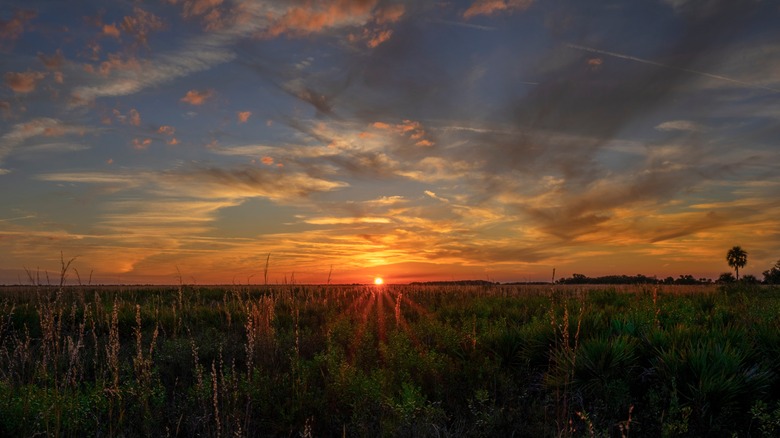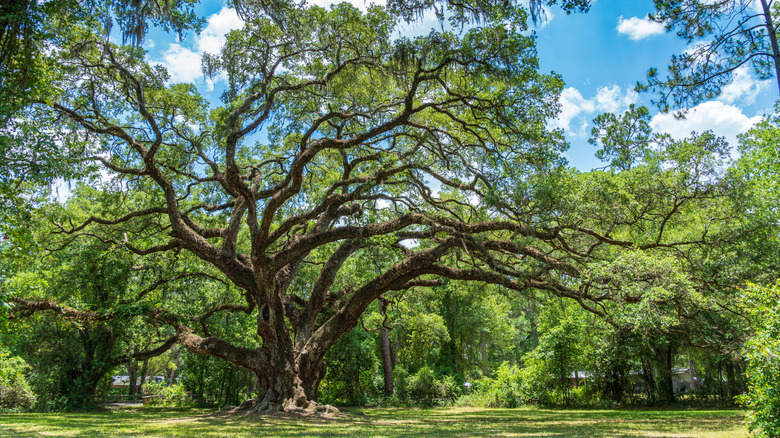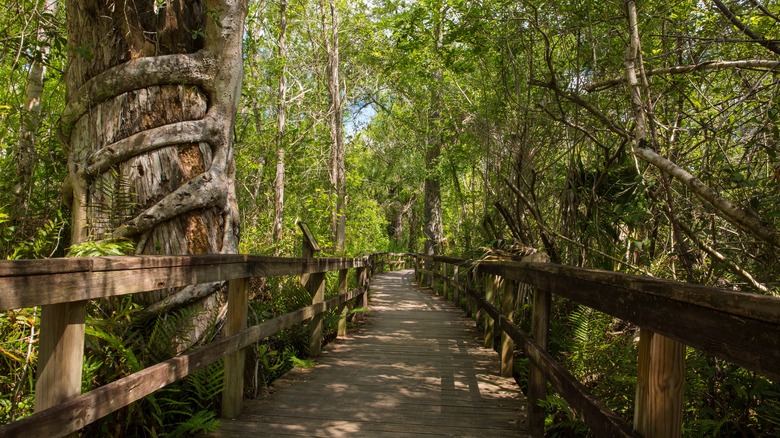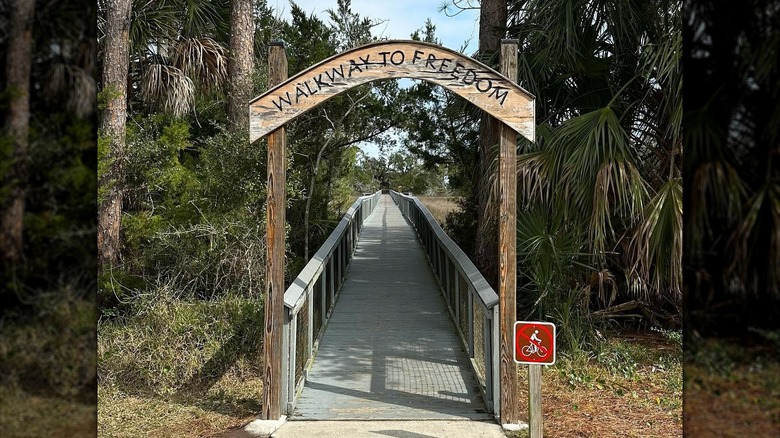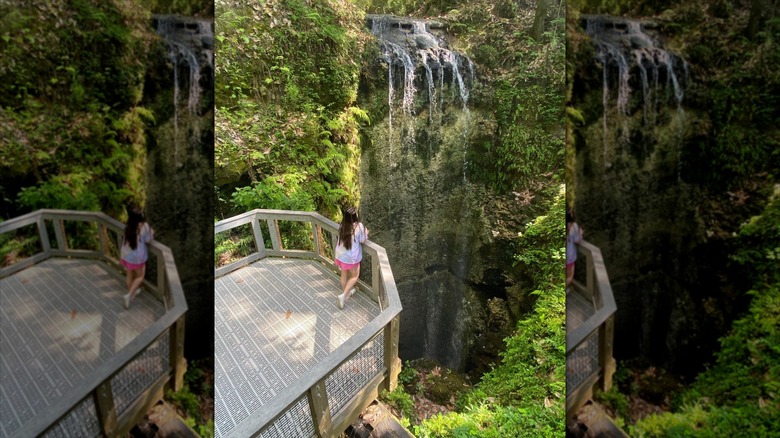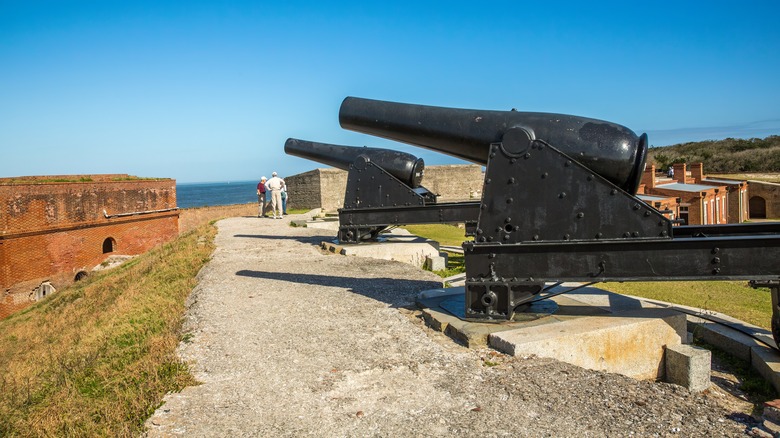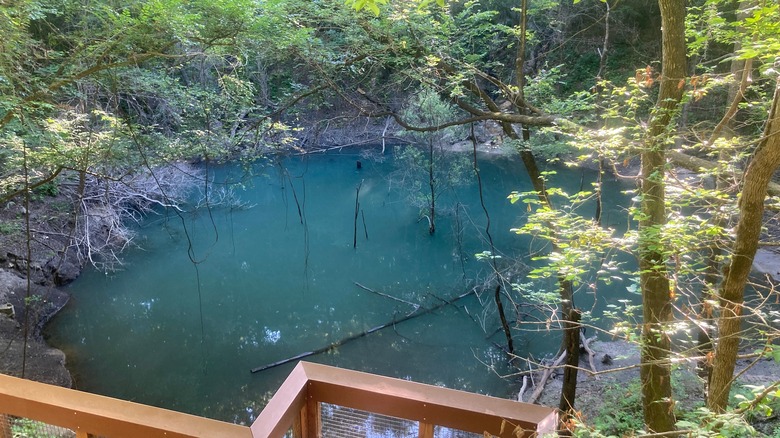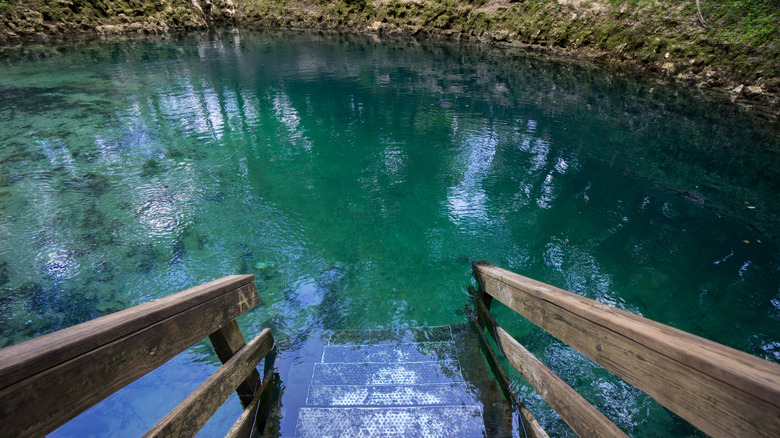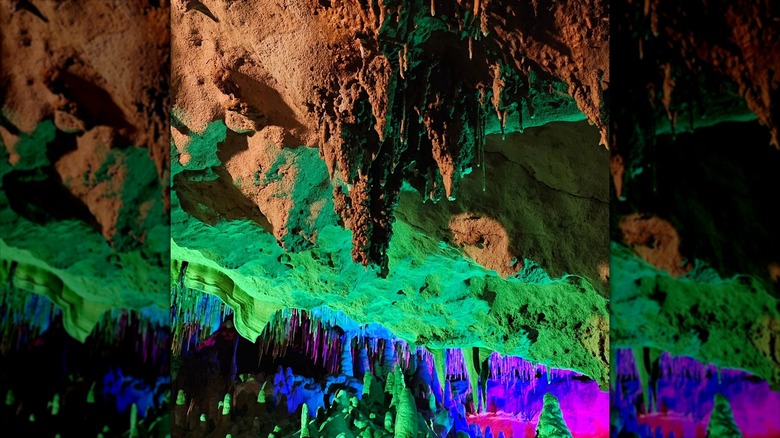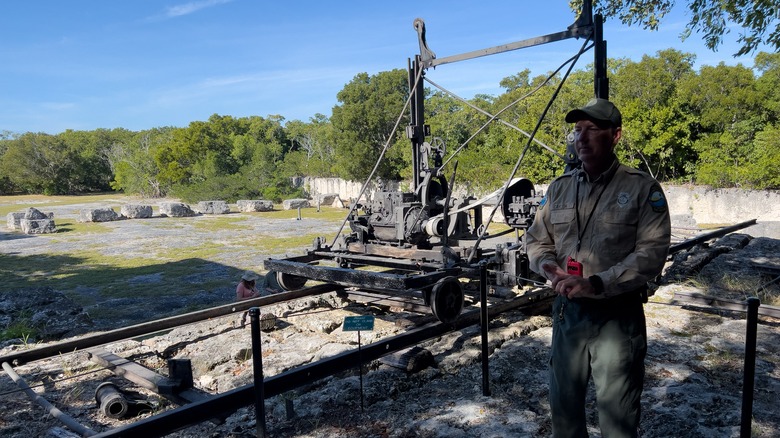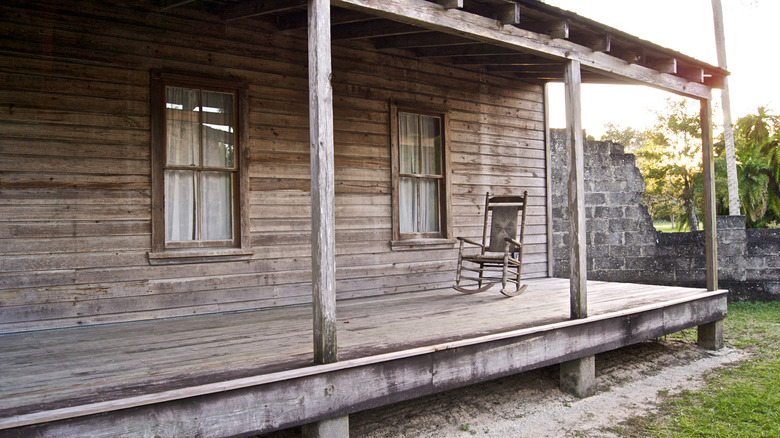The Most Underrated State Parks In Florida
The 175 state parks that dot Florida's landscape combine to produce one of the largest state park services in the country. More than 100 miles of beach coastline and a full catalog of forests, historic sites, trails, and more feature in Florida's cap. Fakahatchee Strand Preserve is Florida's largest and home to a range of plant and animal species that can't be found anywhere else in the continental United States. Fakahatchee is just one of the amazing locations that Florida's State Park Service administers for the benefit of the public.
With so many parks spread across the massive state, it's only natural that some will end up flying under the radar. Much like destinations like Dry Tortugas National Park in the Florida Keys (a truly must-visit East Coast national park site), some of these lesser-visited state parks avoid crowds because of their remote locations. With the major population centers of the state finding themselves sprinkled along the coasts and primarily in the southern half, many inland destinations and North Florida parks see borderline criminal visitor numbers. This is particularly true for many of the most beautifully spectacular and historically significant destinations peppered across the Sunshine State's landscape. These are Florida's most underrated state parks, protected natural and historical sites that everyone should consider planning a trip around.
Kissimmee Prairie Preserve State Park
As with most of these beautiful parks, Kissimmee Prairie Preserve State Park is in a seriously remote spot. The interior destination isn't near any major hub of activity in the state (two hours from Orlando and Fort Myers and two and a half from Tampa and Miami), so it's often passed over by Floridians and visitors alike. Even though the preserve isn't situated between any primary routes of travel, skipping an afternoon or evening in the fascinating grassland landscape is something you'll do at your own peril. The prairie feeds into the Everglades headwaters and remains one of the last dry prairie lands in Florida. As a result, the landscape is a haven for unique bird and wildlife species. Birdwatchers are particularly common at the prairie, as it's home to endangered, threatened, and rare avian critters.
Even if you aren't an avid birdwatcher, the prairie is a wonderful place to spend time. It's a roughly 54,000-acre landscape dominated by interminable grassland fields that seemingly stand in the middle of nowhere. Therefore, the park exhibits some of the smallest degrees of light pollution found anywhere in Florida. Camping overnight here gives stargazers a breathtaking view of the stars above. The night sky is a deep black with natural starlight standing out in vivid detail — so much so that stargazers won't require a telescope or other equipment to enjoy a satisfying view up into the ether.
Dade Battlefield Historic State Park
An hour from Orlando and Tampa alike, Dade Battlefield Historic State Park is easily accessible yet often overlooked in favor of sun-soaked parks and beaches. Perched just inland from the tourist magnets of Crystal Bay and Crystal River (the best U.S. destination for swimming with manatees), the battlefield preserves a complex and critically important saga of American history. The Dade battle was the impetus for the Second Seminole War. This was the longest and costliest conflict between a growing United States nation and the Native Americans who inhabited the land long before European settlers set foot on the continent. The battle occurred in 1835, and the National Historic Landmark (and a part of the Florida State Park system) was established in 1921.
The park covers a landscape of around 80 acres and seeks to preserve the history of a conflict surrounding the larger effort at removing Native Americans from the eastern regions. The war raged against the attempt to forcibly move this population to Oklahoma, something the nascent American government ultimately completed.
The site hosts all manner of educational resources and even puts on a reenactment of the battle every year in January. For those looking to understand the difficult histories of the United States and gain a more complete understanding of their heritage, this is a wonderful option. Of course, the pine forests growing in abundance here also make for a beautiful day out in nature.
Fakahatchee Strand Preserve State Park
The largest state park in Florida, Fakahatchee Strand Preserve State Park is nestled down on the Gulf edge of the Everglades. A short journey from Naples down Route 41 (known as the Tamiami Trail), visitors will want to exit I-75 either at the Miles City junction to take State Road 29 south or follow 41 and then turn onto SR 29 heading north from Carnestown (the crossroads area just north of Everglades City). The park covers an area that extends from I-75 all the way down to Fakahatchee Bay, 85,000 acres in total. From the Copeland entrance on SR 29, visitors can explore the 6-mile Janes Memorial Scenic Drive. It's a dirt and gravel roadway meandering its way northwest through the park, bringing visitors into contact with numerous trailheads flowing farther out into the preserve. Alternatively, when coming from 41, explorers can walk the 2,500-foot Big Cypress Bend Boardwalk that extends north from the Tamiami Trail.
The preserve is a key ecosystem for plant and animal life, including the elusive Florida panther. The area is also home to one of the most abundant native orchid populations in North America. Hiking trails throughout the preserve are uniquely integrated into the park's landscape and history, as every trailhead found within Fakahatchee follows the remains of a tram line route that once served loggers on the hunt for cypress trees. A visit here can be accomplished while crossing the state or visiting nearby Naples.
Fort Mose National Historic Landmark
Okay, it's not completely a state park, but a list of underrated treasures in the state of Florida wouldn't be complete without a mention of this site's immense importance. Moreover, while Fort Mose is officially designated a National Historic Landmark, it's also classified as a Historic State Park cared for under the aegis of the Florida Park Service rather than the national organization. The Landmark lays claim to "the birthplace of African American history." Just north of St. Augustine, Fort Mose was founded in 1738 as an outpost to defend the Spanish territory from potential British invasion and played a pivotal role in rebuffing British advances in 1740. It became the first legally recognized settlement of freed Black men and women who had formerly experienced the horrors of slavery. This piece of its rich tapestry makes Fort Mose so intimately special.
The site initially housed enslaved people from the English colonies to the north, and was named by the National Park Service as a "precursor site of the National Underground Railroad Network." The historical significance of the community can't be understated. Native Americans and free Black men and women helped enslaved people escape plantations in southern colonies, finding freedom and protection in Spanish Florida more than 100 years before the Civil War.
Falling Waters State Park
Falling Waters State Park falls victim to its location, much like many other parks on this list. Visitors simply overlook this fantastic natural recreation area because it's confined to the upper reaches of the Florida Panhandle. Roughly halfway between Pensacola and Tallahassee, the park is closer to Dothan, Alabama, than either Florida city. Yet, it's home to the tallest waterfall in the Sunshine State, at 73 feet. The rushing water falls directly into a sinkhole that reaches down 100 feet into the Earth and forms a cylindrical pit 20 feet wide. Researchers don't know where the terminus of the pit is located, so the water flowing into the sinkhole through the falls above continues on its journey into unknown depths and a mysterious outflow.
Beyond the waterfall, which is a visually stunning scene and a primary draw all on its own, visitors can explore the hiking trails around the area and even camp overnight. The views here are beautiful. North Florida offers a more woodland feel than any of the state's southern climes, a rich environment made all the more engaging by scenic outdoor wonders like Falling Waters' hiking trails and diverse ecology. The area is complete with a lake that's perfect for taking a swim while drinking in the beautiful scenery.
Fort Clinch State Park
Defending the mouth of the St. Mary's River — the water feature separating Florida and Georgia through the entire northward thrust around Jacksonville — visitors will find Fort Clinch. The state park that now encompasses the pentagonal fort that saw its construction begin in 1847 maintains the cannons still pointing northward across the river, as well as the history of the Civil War encampment that came later. Built around the same time that Florida was admitted into the union as a state (1845), the fort parallels Florida's own history in a sense. Situated on 1,400 acres of scenic North Florida riverbank, the park delivers a unique glimpse into history. Over the first weekend of every month, visitors can watch a garrison of soldiers demonstrate battlefield tactics and fire off period-appropriate cannons. The scene isn't something to miss for history buffs.
The riverside location was one of the fortifications occupied by Confederate forces at the outset of the war. It was quickly recaptured and utilized as an integral defensive location by Union troops throughout the remainder of the conflict. Beyond its historical significance and living demonstrations, the park is bathed in live oak trees and beautiful scenery. Hiking trails abound in the waterside location, and sitting down for a picnic is a great way to slow down and enjoy the great outdoors of North Florida.
Devil's Millhopper Geological State Park
A natural phenomenon unlike any other, Devil's Millhopper Geological State Park is dominated by a massive sinkhole and located a little north of the state center. Just a 15-minute drive from Gainesville (a great college town, to be sure), it offers a great day out for University of Florida students in particular. The state park occupies a small sliver of the Gainesville landscape, which perhaps contributes to its relative obscurity, but for those in the know, the geological marvel is a wonderful opportunity to get out into nature and experience a slice of outdoor beauty. The Florida Park Service even calls the landscape at the bottom of this sinkhole "a miniature rain forest."
The sinkhole isn't just a wonderful place to experience Florida's native flora and fauna. The site is a crucial snapshot of the state's subterranean landscape and the limestone bedding that modern Florida is built upon. Sinkholes occur throughout the state as a result of rainwater erosion affecting this limestone footing, but nowhere can such a bountiful example be found. The drop extends down 120 feet beneath the flat land above and measures 500 feet wide at the top, exposing 34 million years of sediment accumulation through more than 100 rock layers. As such a fascinating natural wonder, the park serves to educate aspiring geology students and can underpin a great day out experiencing something truly unique and otherworldly.
Madison Blue Springs State Park
Madison Blue Springs State Park is yet another phenomenal destination hidden away in North Florida. About halfway between Tallahassee and Jacksonville, roughly in line with Valdosta, Georgia, to the north, the park centers around a swimming hole with deep blue water and a picturesque backdrop.
The spring is located just off the Withlacoochee River, which flows north-south and intersects the Suwanee — a historic waterway that's become one of the best adventure getaways in Florida. Visitors come to Madison Blue for its clear spring water and woodland setting. The spring bubbles up from a limestone basin and sports slim dimensions of just 82 feet across and 25 feet deep. Even so, the deep blue hue emanating from the underground spring contributes to a swimming hole that has been named the best in the country. Its location makes it a simple trek for those coming from Jacksonville but a criminally underappreciated spot for swimming and outdoor adventure that nearly all others simply overlook. The mixing of river and spring water at the swimming hole's outlet makes for a warmer affair for anyone timid about the year-round 72-degree Fahrenheit dip (a temperature within the narrow band found universally across Florida's numerous springs).
Florida Caverns State Park
Florida sits right in the sweet spot geographically between some of the most surreal cavern structures in places like Kentucky, Tennessee, and Alabama and those found in Mexico. As a result, visitors and Floridians alike will often be far more focused on beach adventures and other romps into the forests and grasslands of the state's interior. But these caverns near Marianna (not far from the Alabama border and Falling Waters State Park) provide something different. Florida Caverns State Park was opened initially by efforts from the Civilian Conservation Corps — a New Deal-era effort to put Americans to work — and it's the only state park in Florida that features air-filled caves beneath the surface.
The formations in the caves were created over millions of years of erosion and other geological forces, but passages through the rooms were enlarged by workers so visitors could comfortably traverse the subterranean network. Their handiwork can still be seen on the walls and ceilings in the form of targeted chisel marks. A trip into this underground world is something that many people won't have experienced before. This makes a visit down beneath the Earth's surface in one of Florida's most fascinating state parks well worth the effort. American history, Native American regional culture, and the planet's geological processes come together to form a stunning place to explore.
Windley Key Fossil Reef State Park
Thrown out into the southern archipelago that makes up the Florida Keys, Windley Key Fossil Reef State Park is found on Islamorada, just past Key Largo. This makes it somewhat more accessible than destinations farther down US Highway 1 (like Key West, a two-and-a-half-hour drive from Key Largo's access point to the mainland).
Windley Key Fossil Reef is a protected landscape that documents a cross-section of human history in the state and area, and the geological processes that took place much earlier. The area is formed of Key Largo limestone — a fossilization of coral in the island locale — and this formation spans the entire length of the Florida Key island chain. The park documents the very history of these islands and highlights the foundation that allows visitors to soak in the sun on their magnificent beaches. In the early 1900s, however, a new human history came into play to make this site even more interesting and special — the land was sold to the Florida East Coast Railroad. Henry Flagler then established a quarry to extract the limestone for use in building his Overseas Railroad. Even after its completion, the quarry supplied uniquely beautiful stone known as Keystone for use in decorative construction projects until the 1960s. This is a wonderful snippet of Florida history preserved in a not-so-often explored part of the state. Beyond the quarry's walls, you can explore the vegetated landscape that winds its way northward.
Koreshan State Park
Koreshan State Park is far more accessible for Floridians and visitors than many other destinations on this list. Even so, it's far too often overlooked in favor of other outdoor recreational spots. The park is located in Estero, two hours south of Tampa and just a half-hour north of Naples, a stone's throw from Estero Bay and the Estero barrier islands home to the likes of Fort Myers Beach and Lovers Key State Park.
Unlike some of the more popular state parks and other attractions in Florida, Koreshan State Park is a freeze frame in time, showcasing a simpler lifestyle from a past era that no longer exists in the surrounding landscape of hustle and bustle and Floridan modernity. In 1893, a group of religious people led by Dr. Cyrus R. Teed, calling themselves the Koreshans, established a communal living space that could shelter them away. The settlement included agricultural resources like a nursery and botanical garden. Today, 11 restored structures remain on the site, providing modern visitors a time capsule delivering them straight into the past. The forested landscape, still sheltered away from modernity, is also a haven for birds and other native wildlife, as well as towering oaks that complete the picturesque scenery.
